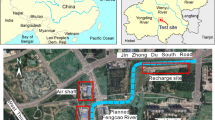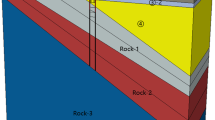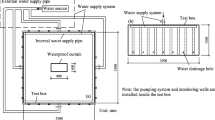Abstract
This paper presents a case study of groundwater control for a deep excavation into confined aquifers in Fuzhou, China. Field pumping tests were first carried out prior to the excavation to investigate the groundwater conditions at the site and as well as to evaluate the feasibility of previous designed dewatering systems (34 m diaphragm walls together with pumping wells). The results showed that under the condition of previous dewatering systems it would have been extremely difficult to safely lower the water level inside the excavation. A co-working scenario of partially penetrating curtains and horizontal waterproof curtain with jet grouting was then proposed to control groundwater inflows. Additional water-tightness assessment tests (WAT) were then performed that allowed to confirm the efficiency of the proposed method. From the feedbacks of WAT, this proposed scenario not only successfully lowered the water lever inside the excavation below the excavation bottom (maximum drawdown up to 14.9 m), but also it minimized the drawdown outside the excavation (less than 0.2 m). Furthermore, an approach was proposed to approximately estimate the hydraulic conductivity of the jet-grouting at the real site from the result of WAT. The hydraulic conductivity of jet-grouted soil is three orders of magnitude lower than that of the original sediments.








Similar content being viewed by others
References
Allan M, Kukacka L (1995) Analysis of core samples from jet grouted soil. Brookhave National Laboratory-BNL-62357. Informal Report, New York, United States of America
Bruce D, De Paoli B, Mascardi C, Mongilardi E (1989) Monitoring and quality control of a 100 meter deep diaphragm wall. In: Burland J, Mitchell J (eds) Pilling and Deep Foundations. A.A Balkema, Rotterdam, pp 23–32
Burbey TJ (2003) Use of time-subsidence data during pumping to characterize specific storage and hydraualic conductivity of semi-confining units. J Hydrol 281:3–22
Cao C, Shi C, Liu L, Liu J, Lei M, Lin Y, Ye Y (2019) Novel excavation and construction method for a deep shaft excavation in ultrathick aquifers. Adv Civ Eng 2019:1827479
Cashman PM, Preene M (2001) Groundwater lowering in construction—a practical guide. Spon Press, London
Chen JJ, Zhang LY, Zhang JF, Zhu YF, Wang JH (2013) Field tests, modification, and application of deep soil mixing method in soft clay. J Geotech Geoenviron Eng 139(1):24–34
Croce P, Modoni G (2007) Design of jet-grouting cut-off. Ground Improv 11(1):11–19
Ding Y, Wang P, Yu S (2015) A new method for deformation monitoring on H-pile in SMW based on BOTDA. Measurement 70:156–168
Forth RA (2004) Groundwater and geotechnical aspects of deep excavations in Hong Kong. Eng Geol 72(3–4):253–260
Kimura M, Inazumi S, Too JKA, Isobe K, Mitsuda Y, Nishiyama Y (2007) Development and application of H-joint steel pipe sheet piles in construction of foundation for structures. Soils Found 47(2):237–251
Liu LH, Lei MF, Cao CY, Shi CH (2019) Dewatering characteristics and inflow prediction of deep foundation pits with partial penetrating curtains in sand and gravel strata. Water 11(10):2182
Liu JW, Shi CH, Cao CY, Lei MF, Wang ZX (2020) Improved analytical method for pile response due to foundation pit excavation. Comput Geotech 123:103609
Ministry of Construction of the People's Republic of China (MCPRC) (2012) Technical specification for retaining and protection of building foundation excavations (JGJ 120-2012)
Pujades E, Carrera J, Vàzquez-Suñé E, Jurado A, Vilarrasa V, Mascuñano-Salvador E (2012) Hydraulic characterization of diaphragm walls for cut and cover tunnelling. Eng Geol 125:1–10
Pujades E, Vàzquez-Suñé E, Carrera J, Vilarrasa V, De Simone S, Jurado A, Ledesma A, Ramos G, Lloret A (2014) Deep enclosures versus pumping to reduce settlements during shaft excavations. Eng Geol 169:100–111
Pujades E, Vàzquez-Suñé E, Culí L, Carrera J, Ledesma A, Jurado A (2015) Hydrogeological impact assessment by tunnelling at sites of high sensitivity. Eng Geol 193:421–434
Pujades E, Jurado A, Carrera J, Vàzquez-Suñé E, Dassargues A (2016) Hydrogeological assessment of non-linear underground enclosures. Eng Geol 207:91–102
Pujades E, De Simone S, Carrera J, Vàzquez-Suñé E, Jurado A (2017) Settlements around pumping wells: analysis of influential factors and a simple calculation procedure. J Hydrol 548:225–236
Roy D, Robinson KE (2009) Surface settlements at a soft soil site due to bedrock dewatering. Eng Geol 107(3–4):109–117
Serrano-Juan A, Pujades E, Vàzquez-Suñé E, Carrera J, Vilarrasa V, De Simone S, Jurado A, Ledesma A, Ramos G, Lloret A (2017) Leveling vs. InSAR in urban underground construction monitoring: pros and cons. Case of la sagrera railway station (Barcelona, Spain). Eng Geol 218:1–11
Shen SL, Wang ZF, Horpibulsuk S, Kim YH (2013) Jet grouting with a newly developed technology: the Twin-Jet method. Eng Geol 152(1):87–95
Shen SL, Wu YX, Xu YS, Hino T, Wu HN (2015) Evaluation of hydraulic parameter based on groundwater pumping test of multi-aquifer system of Tianjin. Comput Geotech 68:196–207
Shen SL, Wu YX, Misra A (2017) Calculation of head difference at two sides of a cut-off barrier during excavation dewatering. Comput Geotech 91:192–202
Shi XQ, Wu JC, Ye SJ et al (2008) Regional land subsidence simulation in Su-Xi-Chang area and Shanghai City, China. Eng Geol 100:27–42
Shi X, Jiang S, Xu H, Jiang F, He Z, Wu J (2016) The effects of artificial recharge of groundwater on controlling land subsidence and its influence on groundwater quality and aquifer energy storage in Shanghai, China. Environ Earth Sci 75(3):195
Shi C, Cao C, Lei M, Peng L, Jiang J (2017) Optimal design and dynamic control of construction dewatering with the consideration of dewatering process. Ksce J Civ Eng 21(4):1161–1169
Vilarrasa V, Carrera J, Jurado A, Pujades E, Vazquez-Sune E (2011) A methodology for characterizing the hydraulic effectiveness of an annular low-permeability barrier. Eng Geol 120:68–80
Wang JX, Feng B, Guo TP, Wu LG, Lou RX, Zhou Z (2013a) Using partial penetrating wells and curtains to lower the water level of confined aquifer of gravel. Eng Geol 161(3):16–25
Wang ZF, Shen SL, Ho CE, Kim YH (2013b) Investigation of field-installation effects of horizontal twin-jet grouting in Shanghai soft soil deposits. Can Geotech J 50(3):288–297
Wang JX, Liu XT, Wu YB, Liu SL, Wu LG, Lou RX, Lu JS, Yao Y (2017) Field experiment and numerical simulation of coupling non-Darcy flow caused by curtain and pumping well in foundation pit dewatering. J Hydrol 549:277–293
Wang JX, Liu XT, Liu SL, Zhu YF, Pan WQ, Zhou J (2018a) Physical model test of transparent soil on coupling effect of cut-off wall and pumping wells during foundation pit dewatering. Acta Geotech 14(1):141–162
Wang JX, Liu XT, Liu JX, Wu LB, Guo QF, Yao Q (2018b) Dewatering of a 32.55 m deep foundation pit in MAMA under leakage risk conditions. Ksce J Civ Eng 22(8):2784–2801
Wu JZ, Wang HM, Yang TL (2009) Experimental research on artificial recharge to shallow aquifer to control land subsidence due to construction in Shanghai city. Geoscience 23(6):1194–1200
Wu YX, Shen SL, Xu YS, Yin ZY (2015) Characteristics of groundwater seepage with cutoff wall in gravel aquifer. I: field observations. Can Geotech J 52(10):1526–1538
Wu YX, Shen SL, Yuan DJ (2016) Characteristics of dewatering induced drawdown curve under blocking effect of retaining wall in aquifer. J Hydrol 539:554–566
Wu YX, Shen SL, Cheng WC, Hino T (2017) Semi-analytical solution to pumping test data with barrier, wellbore storage, and partial penetration effects. Eng Geol 226:44–51
Xu YS, Shen SL, Ma L, Sun WJ, Yin ZY (2014) Evaluation of the blocking effect of retaining walls on groundwater seepage in aquifers with different insertion depths. Eng Geol 183:254–264
Zeng CF, Xue XL, Zheng G, Xue TY, Mei GX (2018) Responses of retaining wall and surrounding ground to pre-excavation dewatering in an alternated multi-aquifer-aquitard system. J Hydrol 559:609–626
Zhang Y, Xue YQ, Wu JC, Ye SJ, Wei ZX, Li QF, Yu J (2007) Characteristics of aquifer system deformation in the Southern Yangtse Delta, China. Eng Geol 90(3–4):160–173
Zhang Y, Wu JC, Xue YQ, Wang ZC, Yao YG, Yan XX, Wang HM (2015) Land subsidence and uplift due to long-term groundwater extraction and artificial recharge in Shanghai, china. Hydrogeol J 23(8):1851–1866
Zhang YQ, Wang JH, Chen JJ, Li MG (2017) Numerical study on the responses of groundwater and strata to pumping and recharge in a deep confined aquifer. J Hydrol 548:342–352
Zheng G, Cao JR, Cheng XS, Ha D, Wang FJ (2018) Experimental study on the artificial recharge of semiconfined aquifers involved in deep excavation engineering. J Hydrol 557:868–877
Zhou N, Vermeer P, Lou R, Tang Y, Jiang S (2010) Numerical simulation of deep foundation pit dewatering and optimization of controlling land subsidence. Eng Geol 114(3–4):251–260
Acknowledgements
Funds from the National Natural Science Foundation of China (Grant no: 51938008, 51778636) are gratefully acknowledged. The authors are also grateful for the funds provided by Guangzhou Metro Design & Research Institute Co., Ltd. and CCCC Strait Construction Investment and Development Co., Ltd. The authors also thank CCCC First Harbor Engineering Co., Ltd. for cooperation in the field tests and data collection for this study. The insightful comments and suggestions from the anonymous reviewers, associate editor and editor are sincerely appreciated.
Author information
Authors and Affiliations
Corresponding authors
Additional information
Publisher's Note
Springer Nature remains neutral with regard to jurisdictional claims in published maps and institutional affiliations.
Electronic supplementary material
Below is the link to the electronic supplementary material.
Rights and permissions
About this article
Cite this article
Cao, C., Shi, C., Liu, L. et al. Evaluation of the effectiveness of an alternative to control groundwater inflow during a deep excavation into confined aquifers. Environ Earth Sci 79, 502 (2020). https://doi.org/10.1007/s12665-020-09253-3
Received:
Accepted:
Published:
DOI: https://doi.org/10.1007/s12665-020-09253-3




